MIIT Tightens Regulations on Intelligent Driving, Restricting Certain Functions
![]() 04/17 2025
04/17 2025
![]() 467
467
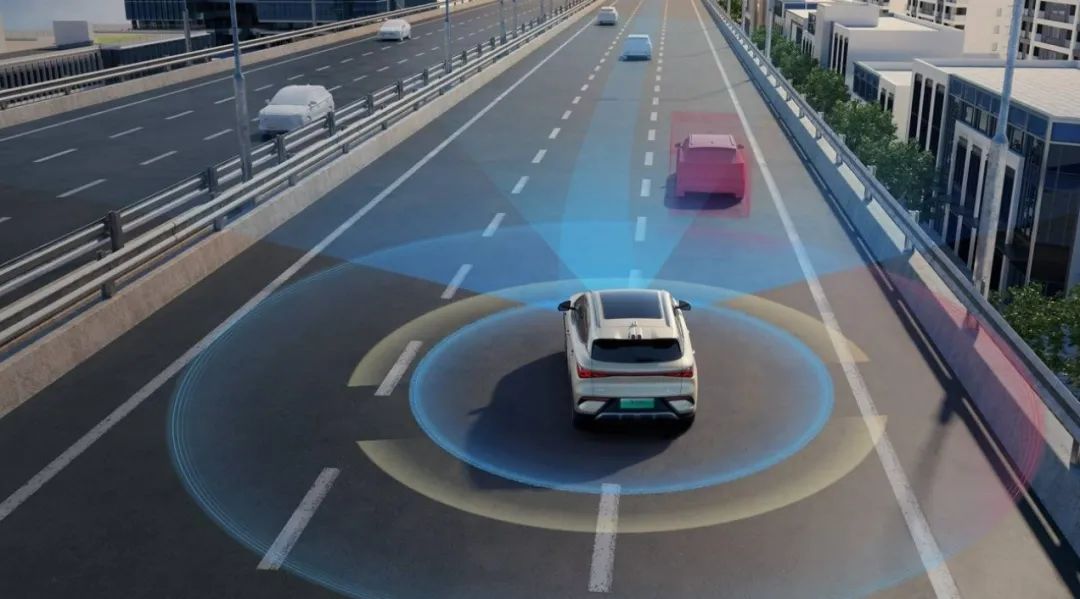
Introduction
Public opinion is divided. Some argue that these measures hinder technological advancement, while others commend them for prioritizing safety. What do you think?
Just two weeks after heated debates over fatal accidents involving intelligent vehicles, the Ministry of Industry and Information Technology (MIIT) has taken decisive action. While this may deliver a significant blow to the entire intelligent driving industry, it ultimately aims to correct and improve standards in this field.
On April 16, the MIIT convened a meeting to discuss the product access and software online upgrade management of intelligent connected vehicles. The meeting reviewed the implementation and suggestions of automakers regarding the "Notice on Further Strengthening the Management of Product Access, Recall, and Software Online Upgrade of Intelligent Connected Vehicles" (hereinafter referred to as the "Notice"), which outlines requirements for product access and software online upgrade filings.
An internal meeting summary document was leaked, revealing new directives and guidelines from national ministries and commissions regarding intelligent driving, Over-The-Air (OTA) updates, vehicle inspections, and rectifications.
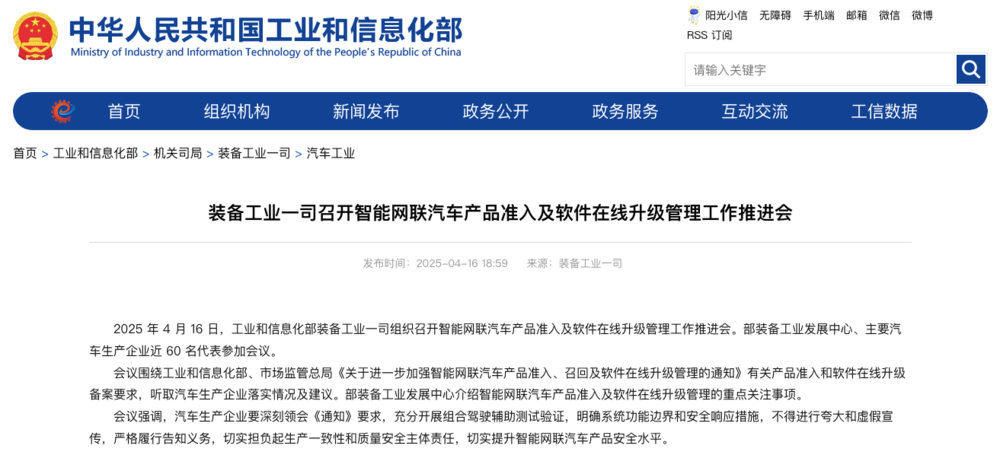
Summary 1: The Equipment Center stated that public testing is prohibited, and all large-scale test groups must undergo an announcement process. Clear and sufficient verification is required, and users cannot be used for testing purposes.
Next Wednesday, a related national standard meeting will be held to discuss accident and incident reporting. Participants can attend as observers, and the meeting notice has been sent to quality control teams.
Equivalency conditions will be considered and specified in the L2 standard. The term "takeover" cannot be used in L2, as it is reserved for L3.
Interpretation: Previously, many automakers adopted a mobile phone-like approach for new intelligent driving versions, allowing a group of pioneering users to test and experience functions and provide feedback on issues and bugs. This accelerated automakers' capabilities and iterations in intelligent driving. However, such testing may no longer be permitted unless it undergoes a similar product announcement and filing process. Intelligent driving functions that have not undergone extensive verification cannot be tested on users, thereby avoiding safety accidents and risks.
If implemented, this measure will delay automakers' levels and iterative capabilities in intelligent driving. Versions that could previously be iterated in a week or a month may now take longer due to the additional process. The relevant national standard meeting will be held soon, and after approval, automakers will be required to comply.
Regarding L2 regulations, new requirements will be introduced, such as prohibiting the use of the term "takeover." This means automakers must avoid using terms like "0 takeovers" during press conferences and promotions, and automotive media will also be restricted in this regard when conducting evaluations.
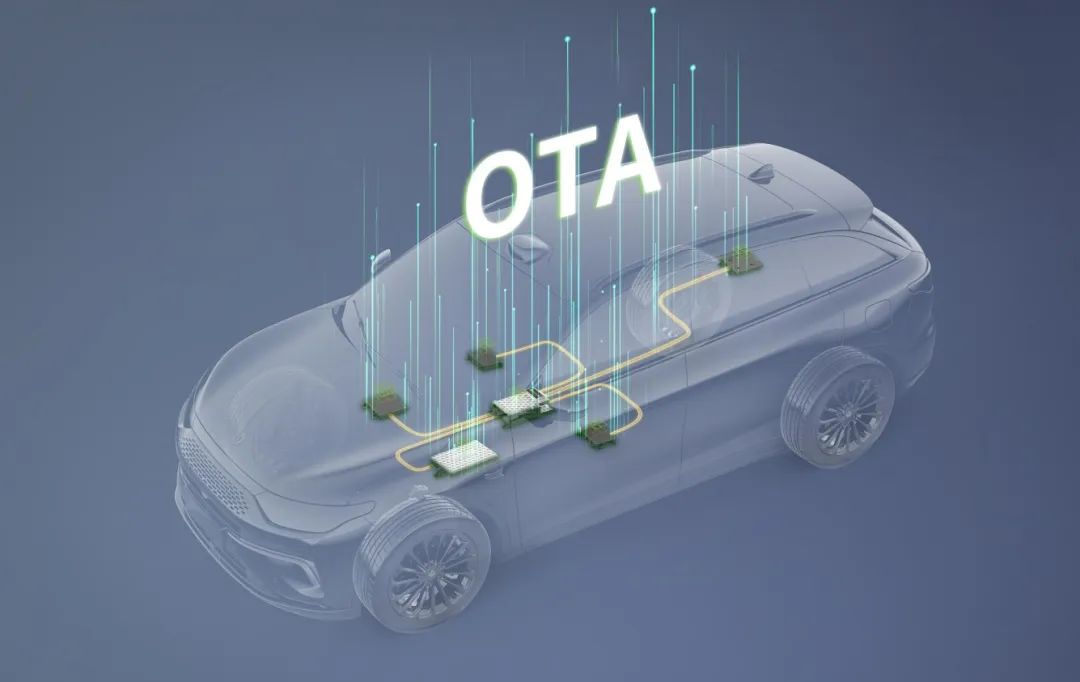
Summary 2: The Automobile Inspection Department emphasized the need for standardized publicity and avoidance of exaggerations. Terms like automatic, autonomous, intelligent driving, and advanced intelligent driving should not be used. Instead, it is recommended to use combined assisted driving.
Criticism was directed at applications that only fill in parameters without submitting verification materials. One of the purposes of the "Notice" is to reduce frequent OTA updates and ensure risk management of versions, with sufficient verification before implementation. Companies with frequent OTA updates will be subject to rigorous scrutiny. Emergency OTA updates require recall, production suspension, and approval from the State Administration for Market Regulation before proceeding.
The question was raised whether technical measures can be taken to prevent drivers from disengaging, such as using face ID recognition for combined driving assistance to prohibit seat adjustment and reclining.
Interpretation: This section imposes strict requirements and restrictions on current popular intelligent driving technologies, tightening the noose on the development of intelligent driving. It specifically mentions the need for standardized publicity and not expanding the boundaries of intelligent assisted driving. In the future, terms like intelligent driving and advanced intelligent driving may also be prohibited to prevent misleading consumers and triggering safety accidents.
Another key point is the strengthening of restrictions on OTA updates. The current market misunderstands OTA, believing that the more frequent the updates, the better the automaker's technological capabilities. However, behind frequent OTA updates lie defects in product software and functions. According to automotive product regulations, defective products must be recalled.
Furthermore, due to the existence of OTA, many automakers inform consumers of currently unavailable functions during promotions, which can easily mislead consumers, especially regarding functions related to driving safety. Consumers may mistakenly believe that such functions exist, leading to potential safety accidents.
Tightening restrictions on OTA updates will make it less likely for automakers to engage in arms races and vicious competition through frequent updates. This will delay the large-scale implementation of some new and unverified functions, which is also responsible for the lives and safety of consumers.
Regarding driver monitoring during assisted driving, higher requirements will be proposed. Technologically, face recognition will be used to prohibit drivers from disengaging from the steering wheel and losing sight. It will also prohibit adjusting and reclining seats during assisted driving, thereby eliminating dangerous driving situations.
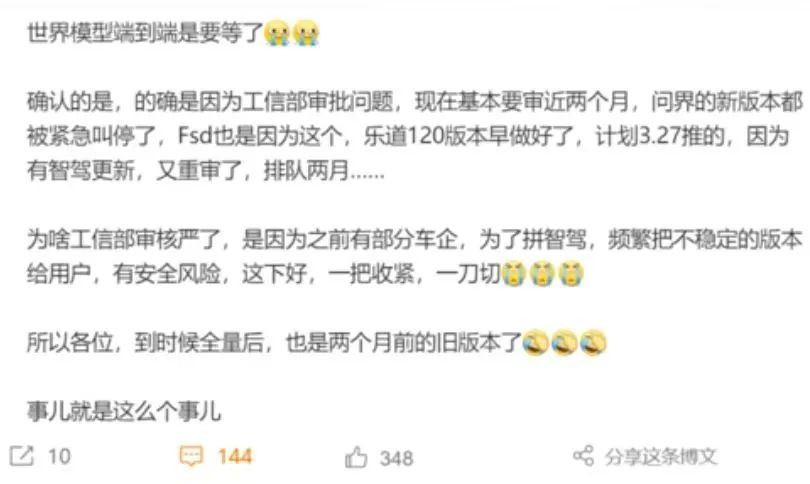
In fact, just a few days ago, a blogger revealed that automakers' end-to-end vehicle launch timelines would be delayed due to stricter vehicle approval processes. The new version of AITO (most likely Kunlun Intelligent Driving 4.0) has also been urgently halted, including the implementation of Full Self-Driving (FSD). These issues will be addressed gradually under supervision.
The reason for stricter reviews is that some automakers frequently pushed unstable versions to users to compete in intelligent driving, easily leading to safety risks. Therefore, the MIIT tightened the policy, and the meeting on the 16th confirmed this.

Summary 3: Regarding common issues in announcement reviews, functions, definitions, and standardized terminology, terms like autonomous driving, intelligent driving (broadly defined), and advanced intelligent driving should not be used. Instead, use (combined) assisted driving, in accordance with automation classification standards.
Assisted driving should use the full Chinese name as much as possible, and the full name should be specified when using English for the first time.
Valet parking, one-click summon, and remote control are prohibited from being declared as they cannot ensure driver-in-the-loop safety during operation. Such products will not be accepted to ensure driver-in-the-loop safety. Descriptions of hands-off and eyes-off should not appear. Hands-off violates traffic laws and should be replaced with driver movement disengagement and visual disengagement.
Eyes-off cannot inhibit hands-off detection, and it cannot be suppressed or turned off. If the hands-off time exceeds 60 seconds, a reasonable explanation is required.
When the user fails to respond timely to the takeover request issued by the driving assistance system, the system should implement the minimum risk strategy to ensure vehicle operation safety, and penalty measures in this regard are required.
Lane Centering Control (LCC) and Navigate on Autopilot (NOA) require collision avoidance tests, and the test report should include testers, time, location, test steps, test items, and test results. The simulation degree and feasibility evaluation should closely monitor regulatory trends and participate in relevant public research. Sufficient time should be reserved for new products.
Interpretation: This section clearly discusses matters related to functions, definitions, and terminology standards. In the future, automakers may not use terms like intelligent driving and advanced intelligent driving in promotions and should strictly follow automation classification standards.
Regarding unsupervised scenarios like valet parking, one-click summon, and remote control, functions where the driver is not in the loop or may not be in the loop will be disabled. It is emphasized that hands-off during assisted driving is prohibited, and such monitoring cannot be suppressed or turned off. The hands-off time cannot exceed one minute. If hands-off exceeds this limit, strategies to ensure vehicle safety, such as slowing down, activating hazard lights, and pulling over, are required. In such cases, drivers should also face penalties, such as being prohibited from using assisted driving functions for a period.
Collision avoidance tests for LCC and NOA need to be more rigorous and standardized, real and effective, and cannot be replaced by simulation tests. If simulation tests are used, supervision is required.
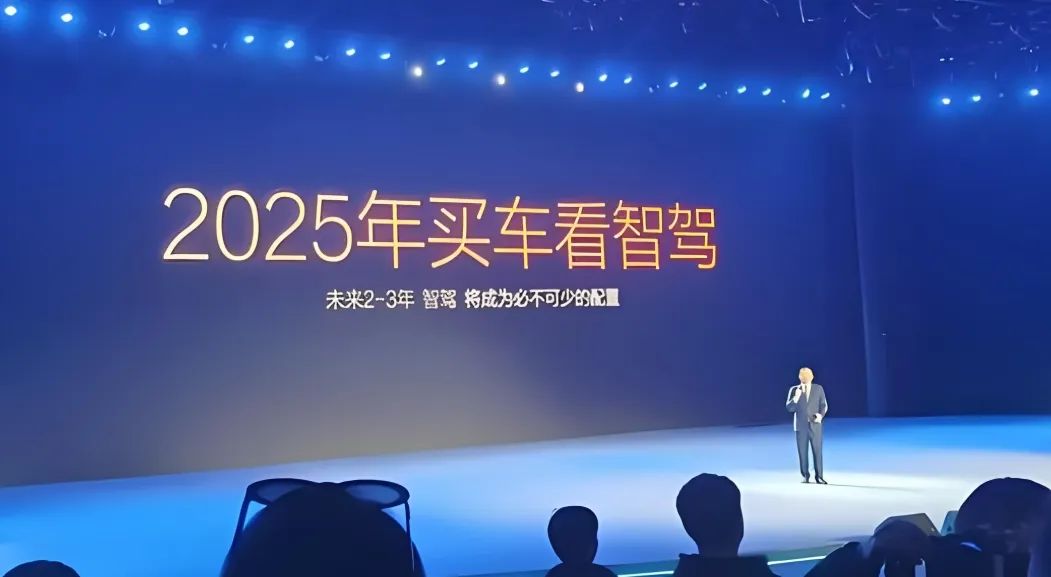
Summary 4: Regarding rectification items, technical specifications and test reports will be checked, and terminology will be standardized. Terms like autonomous driving, intelligent driving (broadly defined), and advanced intelligent driving should not be used. Instead, use (combined) assisted driving. Valet parking, one-click summon, and remote control are prohibited and should be replaced with functions like memory parking. Descriptions of hands-off and eyes-off should not appear and should be replaced with driver movement disengagement and visual disengagement.
Interpretation: This section is a summary and rectification of the meeting, especially regarding professional terminology, the use of intelligent driving terms, and functions like valet parking and recall under conditions where the driver is not in the loop, which will soon be restricted. Rectification requirements for the standardization of hands-off and eyes-off have been reiterated.
After experiencing a public opinion incident involving a certain Xiaomi product, the country has re-emphasized the importance of intelligent driving. It can be said that the lives of three teenage girls directly promoted the standardized development of the intelligent driving industry, making automakers more respectful of safety and life when making technological innovations.
The subsequent impact is expected to be significant, especially for the upcoming Shanghai Auto Show. The industry anticipated that intelligent driving would be a key display and communication point for automakers. However, on the eve of the Shanghai Auto Show, this MIIT meeting can be seen as a official damper on the hype surrounding intelligent driving, providing clear regulations and guidelines for automakers in this field.
Whether to talk about intelligent driving, how to talk about it, what can be said and what cannot be said, and how to restrain oneself will be a huge test for all automakers, akin to dancing with shackles. Moreover, there will surely be differing opinions and viewpoints on the public level. Some argue that these measures hinder technological development, while others commend them for prioritizing safety. Both views are valid, just from different perspectives. The country considers more about safety and social impact.
Of course, this matter will have a significant impact on new-force automakers that focus on intelligent driving. For automakers like Huawei, Xpeng, Li Auto, NIO, and others that were once at the forefront of intelligent driving, they will lose a highlight in their promotions and return to the essence of automotive products. This is beneficial to traditional automakers with weaker intelligent driving capabilities that have been more cautious in this area.
Responsible Editor: Li Sijia Editor: He Zengrong








